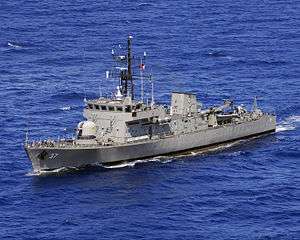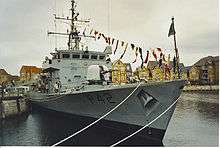Peacock-class corvette
 BRP Artemio Ricarte (ex-HMS Starling) | |
| Class overview | |
|---|---|
| Name: | Peacock class |
| Builders: | Hall, Russell & Company, Aberdeen |
| Operators: | |
| Preceded by: | Castle class |
| Succeeded by: | Falklands Islands class |
| In commission: | 1 December 1982 - 1996 (Royal Navy) |
| Completed: | 5 |
| Active: |
|
| General characteristics | |
| Type: | Corvette |
| Displacement: | 712 tons full load |
| Length: | 62.6 m (205 ft 5 in) |
| Beam: | 10 m (32 ft 10 in) |
| Draught: | 2.72 m (8 ft 11 in) |
| Propulsion: | 2 diesels, 2 shafts, 14,188 bhp (10,580 kW) |
| Speed: | 25 kn (46 km/h; 29 mph) |
| Complement: | 30 - 40 |
| Armament: |
|
The Peacock class is a class of patrol corvette built for the Royal Navy. Five were constructed, and by 1997 all had been sold to the Irish Naval Service or the Philippine Navy.
Original use
The five ships of this class were originally part of the Hong Kong Squadron of the Royal Navy. The ships were built by Hall, Russell & Company of Aberdeen in the United Kingdom and were commissioned into Royal Navy service between 1983 and 1985. They were specifically built for service in Hong Kong with the 6th Patrol Craft Squadron; for work in tropical climates they were fully air conditioned and were capable of remaining at sea during typhoons. As well as ‘flying the flag’ and providing a constant naval presence in region, they could undertake a number of different roles including Seamanship, Navigation and Gunnery training and Search-and-Rescue duties for which they had facilities to carry divers (including a decompression chamber) and equipment to recover vessels and aircraft. They also worked with the Marine Department of the Hong Kong Police and with Customs & Excise to decrease the constant flow of illegal immigrants, narcotics and electronic equipment into the colony. For these roles each vessel could carry two Avon Searider SR5M rigid-hulled inflatable boats and a small detachment of Royal Marines.[1]
Philippine Navy
HMS Peacock (P239), HMS Plover (P240), and HMS Starling (P241) were sold to the Philippines and were officially turned over to the Philippine Navy on 1 August 1997 after Hong Kong was returned to China. In Philippine service they are designated Emilio Jacinto-class corvettes, and have been considerably 'up-gunned' with a 25 mm M242 Bushmaster and two 20 mm Oerlikon guns.
Irish Navy

HMS Swallow (P242) and HMS Swift (P243) were both sold to the Irish Naval Service in 1988.
LÉ Orla (P41) was delivered in 1985 by Hall, Russell & Company[2] as HMS Swift (P243). The ship is named after Orla, a grand niece (great niece) of Brian Boru. She was murdered by her husband around 1090.[3]
LÉ Ciara (P42) was delivered in 1984 by Hall, Russell & Company as HMS Swallow (P242).[4] She passed to the Irish Naval Service in 1988 and was commissioned under her current name by the then Prime Minister Mr C. J. Haughey on 16 January 1989. This ship takes her name from a Tipperary saint born around the year AD611 who, after taking religious vows in her teens, founded a convent in Kilkeary, near Nenagh. While the Royal Navy class these vessels as Offshore Patrol Boats, they are classed as Coastal Patrol Boats by the Irish navy, probably because of the climate in the Atlantic.
They replaced the 3 'Ton class' minesweepers, the last of which the Irish Navy had recently retired before the delivery of the 'Peacock class.
The sale of these almost new vessels to the Irish Navy caused friction between the Royal Navy and the British Government. The British at the time had no patrol boats of this size in home waters and were anxious to use them as patrol / training vessels. It was 2001 before the British Government ordered similar vessels (River Class) for the Royal Navy.
Operators
 Irish Navy
Irish Navy Philippine Navy
Philippine Navy Royal Navy (former)
Royal Navy (former)
References
- ↑ Royal Navy Postwar. Peacock Class Offshore Patrol Vessels.
- ↑ House of Commons Hansard Debates for 23 Oct 1989
- ↑ Irish Naval Service the LÉ Orla webpage Archived October 16, 2007, at the Wayback Machine.
- ↑ House of Commons Hansard Debates for 23 Oct 1989